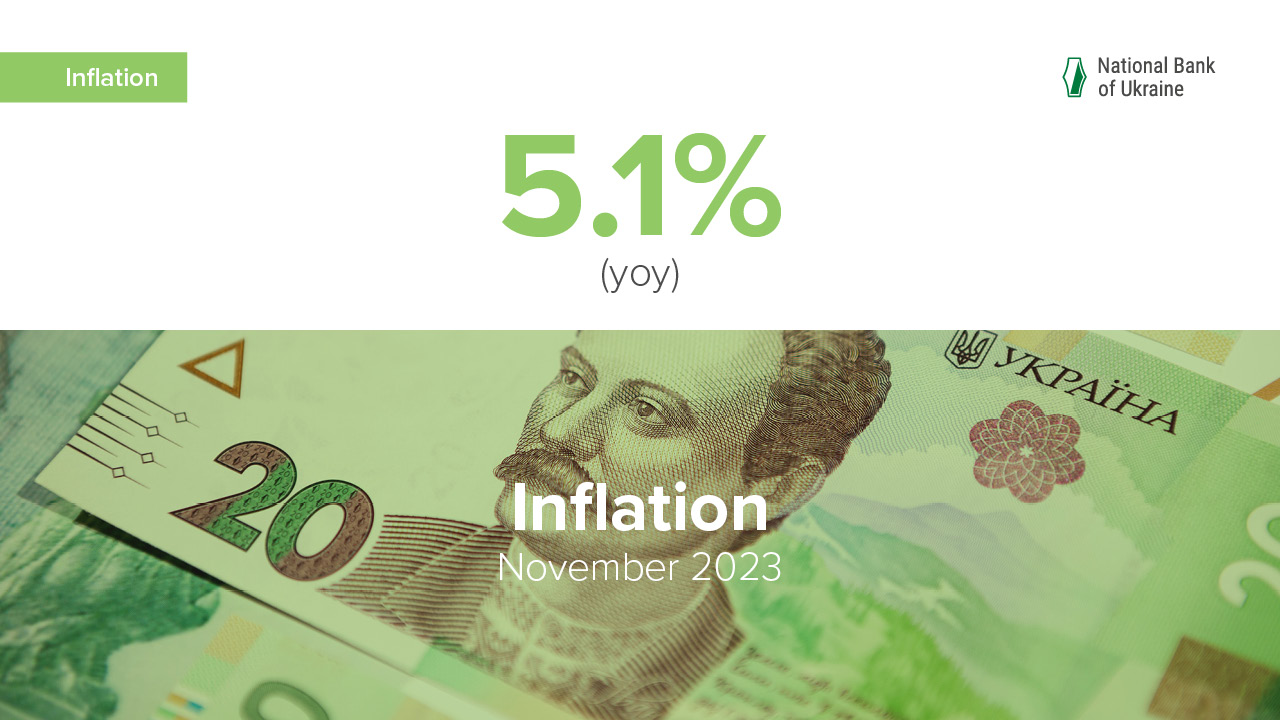In November 2023, consumer inflation continued to decline in annual terms to 5.1% (down from 5.3% in October). In monthly terms, prices increased by 0.5%. This is according to data released by the State Statistics Service of Ukraine.
The actual rates of price growth were somewhat below the trajectory of the NBU’s forecast published in the October 2023 Inflation Report. Core inflation also decelerated slightly faster than expected, primarily due to nonfood price dynamics, including clothing and footwear prices.
Raw food prices declined by 1.5% yoy
Thanks to the good harvest, vegetable prices continued to decrease, but at a somewhat slower rate than in October. The latter was driven by the dynamics of prices for individual products. Specifically, potato prices rose amid a reduction in the supply of lower-quality products. Tomato and cucumber prices came in at almost last year’s levels due to the switch to more expensive greenhouse products. By contrast, most other vegetables became cheaper.
Fruit prices also stood at lower levels than last year, although price decreases for this type of produce decelerated as well. In particular, the drop in banana prices slowed because of higher prices in EU markets and supply chain disruptions. In addition, prices for apples rose due to a smaller supply than last year.
Cereal and flour prices continued to decline, reflecting low export prices and increased production. Egg prices also declined year-on-year as production volumes recovered. The growth in prices for dairy products decelerated.
The increase in administered prices slowed to 10.8% yoy
The growth in prices for alcoholic beverages and tobacco products decelerated yet again as increases in production costs slowed amid pressure from the shadow market supply and an improvement in exchange rate expectations. The moratorium on raising some utility prices for households continued to restrain administered inflation. At the same time, the growth in prices for motor transport services sped up somewhat as fuel prices increased.
Fuel price growth accelerated to 10.2% yoy
Fuel prices rose at a heightened rate in November, primarily due to supply chain disruptions. This had the greatest impact on the cost of LPG. By comparison, other types of fuel fell in price at the end of November, reflecting the trends in the global oil market.
Core inflation decreased to 5.7% yoy
The growth in prices for processed foods continued to decelerate (to 7.3% yoy). These dynamics are explained away by the further easing of pressure from business costs, primarily due to cheaper inputs that go to produce food, the optimization of production chains, and a sustainable situation in the FX market. The decrease in the exports of certain dairy and meat products, primarily butter and chicken, as well as sunflower oil, led to a slowdown in the growth of prices for these foods. Products with a high import share in their cost increased in price at a slower pace. However, this process decelerated a bit due to the blockade of border crossings.
Price increases for nonfood products slowed significantly (to 0.4%) thanks to better inflation expectations amid a stronger hryvnia. Specifically, the year-on-year drop in prices for electronic devices, household appliances, and clothing and footwear continued to deepen. In addition, prices for personal care products, medications, furniture, home appliances, household goods, motor vehicles, and other products rose at a slower clip.
The prices of services also grew less rapidly (11.2% yoy). Cafe and restaurant services grew in price more slowly as pressure eased off from the cost of raw materials used in the production of food. Price increases decelerated for healthcare, veterinary services, financial services, car maintenance, the internet, and beauty salon services. Housing rentals, on the other hand, grew more expensive, which is attributable to migration into big cities.
Inflation decelerated in November, primarily due to a sufficient supply of food and more upbeat expectations as the hryvnia strengthened. At the end of 2023, inflation may come out lower than the NBU projected in its October forecast. However, price pressure and risks of its worsening persist, particularly due to the increased transport and energy components of wartime business costs and because of higher wages and faster-than-expected economic growth. To keep inflation subdued, the NBU will continue to ensure that hryvnia assets are sufficiently attractive and to maintain its active presence in the FX market in order to preserve exchange rate sustainability.







